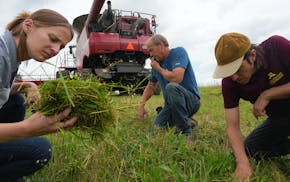As supporters and lawyers for Republican Sen. Norm Coleman and DFLer Al Franken trade accusations and gear up for a statewide hand recount of the ballots cast on Nov. 4, it might be instructive for them -- particularly those from out of state -- to look back at the 1962 gubernatorial race in Minnesota. That race showed voting in Minnesota was honest. As many a student of state history knows, Republican Gov. Elmer L. Andersen was initially certified the winner, but a recount made DFL Lt. Gov. Karl Rolvaag the new governor by a mere 91-vote margin of the 1.3 million cast. In 1982, as a reporter for United Press International in Illinois, I had the opportunity to talk to both Andersen and Rolvaag about their memories of the '62 race. Illinois had just had a very close gubernatorial election, and there was talk of a recount there. Rolvaag died in 1990 at 77. Andersen died in 2004 at 95. Here is part of the story that I wrote 26 years ago. Rolvaag, contacted at his Bowstring Lake home in northern Minnesota, reminisced about the election 20 years ago.
"I told my wife that win, lose or draw, we would go on vacation to Mexico," he said. "I went to bed early Wednesday morning with a big lead but by the morning's light I was behind. On Thursday, the lead kept see-sawing. On Saturday, I said, 'Let's go,' and the headline read, 'Rolvaag leads by one vote.' I was ahead by 300 when I got back and 10 hours later I was behind by 185.'"
Andersen, in a telephone interview from his St. Paul firm of H.B. Fuller Co., said the experience -- although he lost in the end -- was proof that the system worked and the government functioned.
"The government went on from November to March," Andersen said. "Since I had been certified as governor, I continued as governor. The Legislature met and life went on even though the people did not know who had been elected governor. It reflected great stability and strength in the system."
While the process proceeded, Andersen conducted the affairs of state from his plush office in the Capitol's executive suite. In the basement, Rolvaag had a small bare room with a tile floor, no curtains on its single window and steam pipes.
Staff in both offices answered the phone, "governor's office."
Rolvaag emerged the winner by 133 voters after the initial recount and later a three-judge panel, appointed by the Minnesota Supreme Court, ruled on some 1,300 challenged ballots and declared Rolvaag the winner by 91 votes on March 21, 1963.
William Fox, UPI reporter in Minneapolis, who covered the Rolvaag-Andersen recount, said paper ballots from the rural areas held the key to the election. "Some paper ballots had all sorts of markings, some had been used by election judges to keep score of various card games, others had coffee cup rings and various notes," Fox remembered.
He spent nearly a month in a St. Paul courtroom watching three judges and several attorneys study the challenged ballots.
"The courtroom was lined with files containing the ballots," Fox said. "The general rule adopted by the court was that a ballot was counted if the voter's intention was clear, no matter what else happened to the ballot."
Rolvaag recalled one "dramatic little story" that emerged a few days after the election. Votes were being counted in the backwoods of northern Minnesota where there were no telephones. A snowstorm struck, delaying the reporting of the handful of ballots. A bush pilot flew the ballots out three days after the election.
As in Illinois, there were charges of voting irregularities. At one point, Republicans claimed they knew of places in northern Minnesota where Canadians had voted. And DFLers charged possible irregularities at St. James, where ballots were removed from a sealed jail cell and almost hauled away to the dump.
But in the end, no one proved any fraud.
"The wonderful thing we learned in Minnesota was no fraud came out in the voting differences. The closest scrutiny indicated voting in Minnesota was honest," Andersen said.
Pamela Huey is a copy editor and occasional staff writer for the Star Tribune.
Opinion: Are Americans fed up with democracy?
Brown: The good, bad and ugly of Trump's blessing U.S. Steel, Nippon deal
Opinion: Improving trend in Minnesota's suicide rate is a milestone, not a finish line

